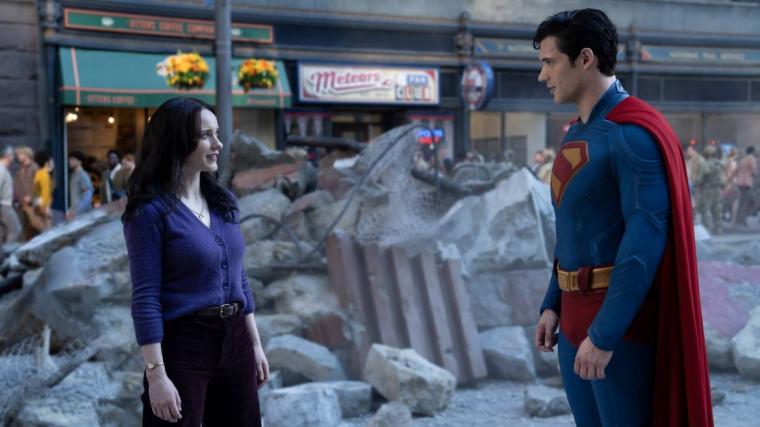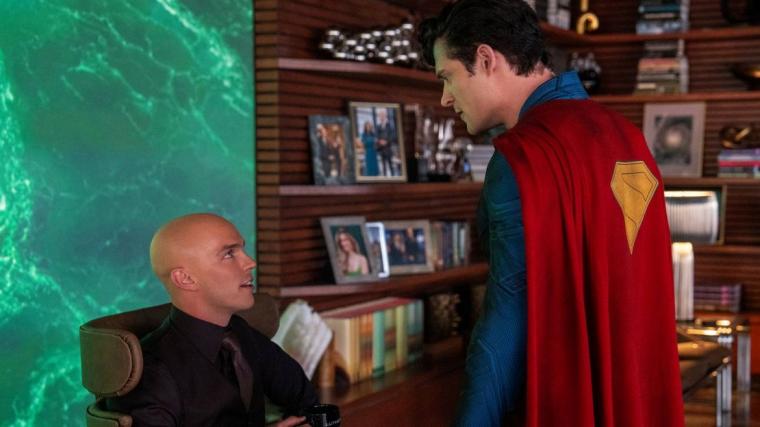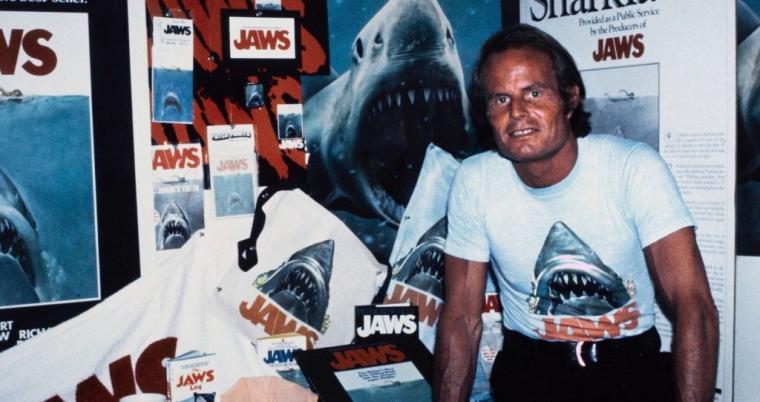
David Corenswet in Superman
SUPERMAN
As most everyone will likely agree, the best thing about 1978's Superman is Christopher Reeve. And happily, though perhaps more arguably, the best thing about writer/director James Gunn's new Superman is David Corenswet, the 32-year-old tasked with breathing fresh life into this costumed crime fighter (and his alias Clark Kent) whom, by this point, we're all too familiar with.
Days after seeing it, I'm still not sure how much, or even if, I like Gunn's reboot, which is wildly overstuffed and tonally messy, and features far more scenes of the Man of Steel getting his ass kicked than kicking ass. The film occasionally ties itself into knots trying to turn the invincible into an underdog. Yet this big swing is also more fun than most generically solid comic-book movies, because it's a determinedly weird one, and largely held together by Corenswet's devastating sincerity and well-employed comic chops. There was a lot that puzzled me. But when, in his first 10 minutes on-screen, this Superman surveyed a scene of canine-fueled demolition with an aghast “What the hey?!” – “heck” evidently being too strong a curse word – I instantly sensed we were in good hands.
Recently installed as co-chairman and -CEO of DC Studios, Gunn is probably best-known as the creative force behind Marvel's three volumes of Guardians of the Galaxy, and as the opening scene here demonstrates, the ticklish DNA of those action comedies is baked into his Superman, as well. Blessedly, Gunn assumes that we're up-to-speed on the character's history, and after some expository preamble (accompanied by John Williams' iconic trumpet blares), we're off to the Fortress of Solitude, a punch from our hero's latest adversary having knocked him, conveniently enough, all the way to Antarctica. Equally conveniently, it only takes a whistle for help to arrive, which it does in the form of Krypto, a white, floppy-eared mutt with the cutest little red cape you've ever seen. Even if you're predisposed to roll your eyes at lovable CGI animals in human clothes, you gotta hand it to Gunn: the super-dog Krypto is trés adorbs. Better still, this fiercely loyal, maniacally hyper pup is funny, and so is Corenswet, and so is the team of robotic assistants (its leader voiced by Alan Tudyk) obligated to heal their boss and repair Krypto's accidental demolition of the fortress. Shrewdly yet offhandedly, this introductory sequence manages to echo and salute Richard Donner's 1978 movie while also implying that the vibe will be distinctly James Gunn – and it is. But that vibe turns out to be less Guardians of the Galaxy than Guardians of the Galaxy Vol. 3, and for some of us, that's a bit problematic.

Although there were still plenty of wisecracks amid the budget-busting action scenes, you may recall that much of Vol. 3 was devoted to an origin story for Rocket Raccoon, and it was such a grim one that it was tough to jump back into the film's freewheeling silliness after witnessing the suffering of so many GCI animals. Gunn's Superman is a little like that. Beyond just about everything to do with Krypto, there's a surfeit of pure comedy in the film, much of it legitimately hilarious: Superman's unwavering, some might say misguided devotion to protecting all living beings, be they a squirrel or a skyscraper-sized Kaiju; the sharp workplace banter at the Daily Planet (whose staffers include Wendell Pierce's Perry White, Skyler Gisondo's unexpectedly studly Jimmy Olsen, and, finest of all, Rachel Brosnahan's Lois Lane); the tetchy hostility between the teammates-but-not-friends who compose the metahuman Justice Gang (Edi Gathegi's Mister Terrific, Isabela Merced's Hawkgirl, and Green Lantern, whom Nathan Fillion plays as one of his trademark obnoxious louts à la Captain Hammer in Dr. Horrible's Sing-Along Blog). Other stabs at humor, such as the cornpone stereotypes of Ma and Pa Kent (Neva Howell and Pruitt Taylor Vince) and the shrill dim bulb that is Eve Teschmacher (Sara Sampaio), don't fare so well, but at least do their part in keeping the mood light.
Yet how are we to reconcile all this good-natured insouciance with Gunn's determination to place his DC figures in a real-world context, where you don't have to squint to the see the unsettling parallels? To be sure, the writer/director may not have specifically designed the film's central conflict between the invented Middle Eastern countries of Boravia and Jarhanpur to bring to mind Israel and Palestine. That doesn't mean you don't think about the actual crisis anyway, just as, when Lex Luthor (an excellent, gratifyingly intense Nicholas Hoult) traps his enemies – even an ex-girlfriend! – in a “pocket dimension,” you can't help but think of Guantanamo, or wherever ICE is “escorting” immigrants to these days. A prisoner is shot in the head at point-blank range. A cable-news station that's unmistakably a FOX stand-in airs conspiracy theories and accuses Superman of “grooming” the people of Earth. Said station also cozies up to Lex, taking as gospel the unsmiling, unhinged ramblings of an unspeakably rich megalomaniac. By all means, setting a comic-book flick in a world that feels uncannily close to ours can work. Maybe not terribly well, though, when it's also asking us to believe in the goofiness of eyeglasses that alter people's perception of your face, or the sight of thousands of jabbering monkeys typing away to create outraged social-media posts.

That said, the film's hands-down high point is also its most realistic encounter. As we quickly discover, Lois and Clark have been secretly dating for months, and Lois knows that Clark is in fact Superman. We also learn, more surprisingly, that Clark Kent is a very bad, ethically compromised journalist, his “interviews” with Superman frequently landing on the Planet's front page. This irks the ultra-professional Lois to no end, as well it should, and results in her finally getting her own interview in which she grills Superman/Clark about his interference in geopolitical matters and, in general, his habit of acting above the law. Without question, this is the most richly written and acted sequence in the film – in any of Gunn's films – and anyone who's ever had a stinging fight with a romantic partner will recognize the dynamics … though perhaps not relate to Clark's difficulty, when explaining himself, in separating “he” from “I.” Corenswet and Brosnahan are phenomenal in this scene, and so palpably sell Lois' and Clark's battle of intellectual equals and deep affection for one another that it's a shame we don't get to see more of them together. Soon enough, though, Lois is heading off on a rescue mission with Mister Terrific, and Superman is getting the stuffing beaten out of him again and again and again.
While it was a ballsy move on Gunn's part to open his Superman with the guy bruised and bloodied, I honestly didn't expect that to be the character's signature look through the course of the film. Yet barring his involvement in that Kaiju attack and his late-film mano a mano with fellow metahuman Ultraman, I'm struggling to think of moments in which our titular superhero gets to be, y'know, a superhero. More frequently, he's just a punching bag. Halfway through the movie, Superman is essentially felled by Kryptonite, the withering effects of which last for the next half-hour, and he routinely goes through so much bodily wear and tear that I didn't reflect on Christopher Reeve so much as Jim Caviezel in The Passion of the Christ. (That's not even counting the emotional wear and tear that comes from learning what his birth parents – played, in cameos, by Bradley Cooper and Angela Sarafyan – initially decreed regarding their son's tenure on Earth.) A fallible Superman is a refreshing thing. Gunn, however, goes almost too far in this direction, and although Krypto is always good for a laugh, the number of times our Metropolis wonder has to be saved by his pooch gets to be a little embarrassing.
Believe it or not, despite all the aforementioned incident, there's even more to unpack: a malevolent yet awfully boring super-nemesis named The Engineer (María Gabriela de Faría), genetically altered to be more machine than human; an experiment in cloning that feels like it should've been saved for a sequel; the arrival of Krypto's actual owner who hints at feistier, potentially randier adventures down the line. All told, Gunn's DC reboot is a lot. Possibly too much. Yet it's at least alive in ways that superhero movies rarely are anymore, and it certainly runs circles around the lugubriousness of the Zack Snyder years and the deadening mediocrity of most every recent Marvel. Plus, unlike Chris Evans' Captain America, Corenswet's square-jawed champion of truth, justice, and whatever “the American way” is defined as nowadays isn't dully noble; the actor is legitimately moving in his goodness, and Gunn understands that a protagonist this impossibly virtuous is just aching to be taken down a peg or two. So no, I'm still no closer on knowing whether I liked Superman. But I'd definitely be willing to give it a couple more tries in order to find out.

JAWS @ 50: THE DEFINITIVE INSIDE STORY
Near the start of director Laurent Bouzereau's National Geographic documentary Jaws @ 50: The Definitive Inside Story – which recently began streaming on Disney+ and Hulu – Steven Spielberg is asked by the off-screen interviewer whether he has anything new to say about his cinematic landmark that essentially originated the concept of “summer blockbuster” a half-century ago. Spielberg's reply is “Let's find out!” To cut to the chase: No. No, he doesn't. If you've seen any of the dozens (hundreds?) of docs at least tangentially related to this greatest of all aquatic thrillers, be it a DVD bonus feature or 2017's feature-length Spielberg, you no doubt know these stories and their particulars by heart: the malfunctioning shark; the crap weather; the director's certainty that he would be fired at a moment's notice, and for good reason.
Is that any reason to avoid Jaws @ 50? Hell, no. Jaws is one of the most endlessly re-watchable movies of all time, and if you're a fan, the only reason you might want to stop viewing the documentary's brisk 88 minutes is to immediately switch over to the genuine article. And it's not like Bouzereau's doc is void of fresh avenues or perspectives. The smart, engaging talking heads include members of novelist Peter Benchley's family, experts in ichthyology, and deeply influenced filmmakers – some you wouldn't necessarily expect – such as James Cameron, Robert Zemeckis, Jordan Peele, Quentin Tarantino, Guillermo Del Toro, J.J. Abrams, Cameron Crowe, and, wearing a Jaws T-shirt, Steven Soderbergh. (Also Emily Blunt, for reasons passing understanding.) We get delightful behind-the-scenes footage galore, some of it, to this obsessive's memory, being shown for the first time. There's great stuff on the film's early drafts and shooting prep and legacy and merch. And perhaps most importantly for some of us, there are new interviews with Jeffrey Voorhees and Susan Backlinie, who respectively played shark victims Alex Kintner and Chrissy (no last name given). I would've loved the hugely entertaining if rarely illuminating Jaws @ 50: The Definitive Inside Story regardless, but it sure was nice to see Voorhees and Backlinie again, alive and kicking, 50 years after their on-screen demises. Sadly, no word on what became of Pipit.










